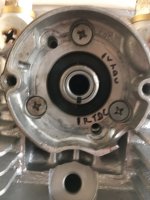LTGTR
XS650 Addict
Could you help my understanding of which is the best way to find TDC.
I have read all/most of the posts about the different ways to find TDC on our XS650's on this forum, but I cant really say one of those methods ended up being the effective way to do it.
For example, the plug angle is too much for the piston to push up a dial indicator or plunger bored through an old spark plug and the piston stop method wont work because it will foul on the valves when you reverse the rotation (approx 360). Maybe my understanding of the Piston Stop method is not right - the theory of this method is certainly accurate.
There are some other methods on this forum but they seem extremely technical and involved - no disrespect to those that constructed them.
Of course my question assumes you dont have the TDC mark on the Rotor and you have to find it from scratch.
Thanks for any help,
Regards Ray.
I have read all/most of the posts about the different ways to find TDC on our XS650's on this forum, but I cant really say one of those methods ended up being the effective way to do it.
For example, the plug angle is too much for the piston to push up a dial indicator or plunger bored through an old spark plug and the piston stop method wont work because it will foul on the valves when you reverse the rotation (approx 360). Maybe my understanding of the Piston Stop method is not right - the theory of this method is certainly accurate.
There are some other methods on this forum but they seem extremely technical and involved - no disrespect to those that constructed them.
Of course my question assumes you dont have the TDC mark on the Rotor and you have to find it from scratch.
Thanks for any help,
Regards Ray.


